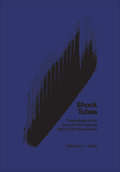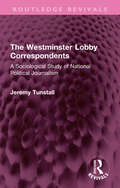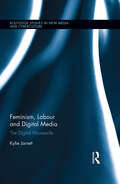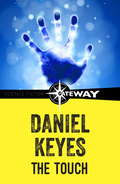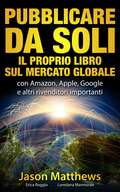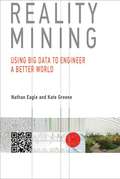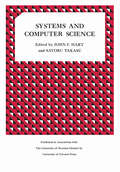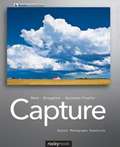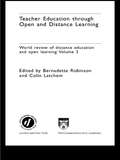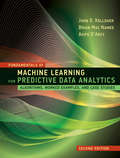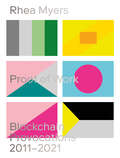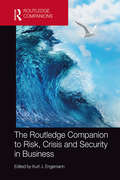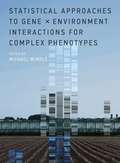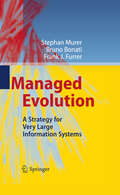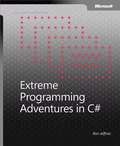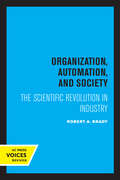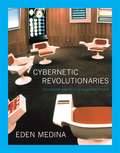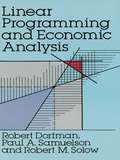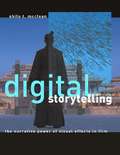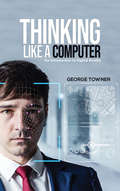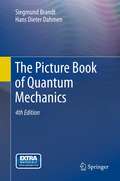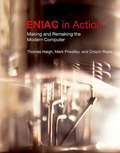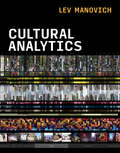- Table View
- List View
Shock Tubes: Proceedings of the Seventh International Shock Tube Symposium held at University of Toronto, Toronto, Canada 23-25 June 1969
by Irving Israel GlassThis volume contains the proceedings of a symposium held at the University of Toronto in June 1969. The symposium consisted of six sessions; each containing an invited paper, followed by six contributed papers reporting on recent, relevant research and development. The topics are: a review of research problems in basic shock tube flows and the possibilities for the shock tube in the future; driving techniques; explosive drivers; theoretical and experimental research in electromagnetic shock tubes; chemical kinetics and spectroscopy; and a review of shock tube diagnostics, instrumentation and fundamental data as well as the measurement of physical quantities.
The Westminster Lobby Correspondents: A Sociological Study of National Political Journalism (Routledge Revivals)
by Jeremy TunstallThe Westminster Lobby correspondents have a special place in both the politics and the mass media of Britain. These journalists dominate the behind-the-scenes reporting of British national politics. In this book, originally published in 1970, Jeremy Tunstall presents the first systematic social science study of the uniquely British phenomenon of Lobby correspondents.The study includes data collected from interviews with the national Lobby correspondents, who also completed lengthy questionnaires. It contains evidence of their careers, political opinions, pay, working conditions, relationships with their employing news organization and political news sources, and on the way in which the correspondents both compete with, and exchange information with, each other. As well as this fascinating empirical data, the book offers an important contribution to the sociology of politics and the mass media, and to the study of ‘organizational intelligence’ and the sociology of occupations.There had long centred upon the Lobby correspondents many myths and misconceptions, which Jeremy Tunstall effectively demolishes. (The so-called ‘Lobby rules’ were here published for the first time.) Other real dilemmas are, however, revealed: the competing demands of publicity and secrecy; the dilemmas of British politics in which basic principles – such as Parliamentary supremacy and Cabinet secrecy – are daily breached, not only by the correspondents, but also by leading politicians; and the problems of a system of political communication whose obsession with daily news values is so similar to official and academic contributions. With media and politics still very much linked today, this reissue can be read and enjoyed in its historical context.
Feminism, Labour and Digital Media: The Digital Housewife (Routledge Studies in New Media and Cyberculture)
by Kylie JarrettThere is a contradiction at the heart of digital media. We use commercial platforms to express our identity, to build community and to engage politically. At the same time, our status updates, tweets, videos, photographs and music files are free content for these sites. We are also generating an almost endless supply of user data that can be mined, re-purposed and sold to advertisers. As users of the commercial web, we are socially and creatively engaged, but also labourers, exploited by the companies that provide our communication platforms. How do we reconcile these contradictions? Feminism, Labour and Digital Media argues for using the work of Marxist feminist theorists about the role of domestic work in capitalism to explore these competing dynamics of consumer labour. It uses the concept of the Digital Housewife to outline the relationship between the work we do online and the unpaid sphere of social reproduction. It demonstrates how feminist perspectives expand our critique of consumer labour in digital media. In doing so, the Digital Housewife returns feminist inquiry from the margins and places it at the heart of critical digital media analysis.
The Touch
by Daniel KeyesThe ultimate 'what if' novel, from the million-copy-bestselling author of FLOWERS FOR ALGERNON: 'A masterpiece of poignant brilliance ... heartbreaking' GuardianKaren and Barney Stark should never have married. Childless, uncomfortable and incompatible, their marriage has not been a success, and the lack of a child only makes the tension between them worse. And living their lives to the beat of a fertility clock only adds to the increasingly volatile atmosphere.When an incident at Barney's workplace causes them both to be unknowingly contaminated with radioactive dust, they also become pariahs - in their neighbourhood and with their families. But things are only going to get worse. Karen discovers she is pregnant and as their closest friends become frightened enemies, the dream of becoming parents turns into a nightmare...
Pubblicare da soli il proprio libro sul mercato globale
by Jason Matthews Erica Roggio e Loredana MarmoraleHai scritto un libro? Vuoi vendere su Amazon, Apple, Google e altri importanti rivenditori? Risparmia tempo e denaro vendendo e-book online con questa semplice guida all'auto-pubblicazione. Risolvi i tuoi dubbi su come preparare il tuo libro per caricarlo sulle piattaforme dei principali rivenditori. Il manuale, che include consigli per far emergere il tuo libro rispetto a tanti altri, è stato scritto da Jason Matthews, esperto di auto-pubblicazione e autore di numerose opere letterarie di narrativa e saggistica. I suoi libri sono stati tradotti in 8 lingue e i suoi corsi video sono stati seguiti da studenti di oltre 123 paesi. Preparati a raggiungere velocemente gli obiettivi di pubblicazione. Imparerai a: •formattare il tuo libro per i principali rivenditori •convertirlo in ePub in modo che sia visualizzato correttamente su tablet, smartphone e Kindle •disegnare una copertina accattivante •vendere attraverso Amazon, Apple, Google Play, Barnes & Noble, Smashwords, Kobo e altre piattaforme •utilizzare i social media in maniera intelligente (Facebook, Twitter, Google Plus, YouTube) •bloggare e creare la tua piattaforma autore •ottenere recensioni, e tanto altro ancora. Trova soluzioni per le tue esigenze di modifica, copyright, ISBN e altri requisiti, oltre alle migliori opzioni e strategie per lavorare con i professionisti. I lettori di tutto il mondo sono affamati di nuovi libri. Sei pronto a condividere il tuo? Inizia oggi!
Reality Mining
by Kate Greene Nathan EagleBig Data is made up of lots of little data: numbers entered into cell phones, addresses entered into GPS devices, visits to websites, online purchases, ATM transactions, and any other activity that leaves a digital trail. Although the abuse of Big Data -- surveillance, spying, hacking -- has made headlines, it shouldn't overshadow the abundant positive applications of Big Data. In Reality Mining, Nathan Eagle and Kate Greene cut through the hype and the headlines to explore the positive potential of Big Data, showing the ways in which the analysis of Big Data ("Reality Mining") can be used to improve human systems as varied as political polling and disease tracking, while considering user privacy.Eagle, a recognized expert in the field, and Greene, an experienced technology journalist, describe Reality Mining at five different levels: the individual, the neighborhood and organization, the city, the nation, and the world. For each level, they first offer a nontechnical explanation of data collection methods and then describe applications and systems that have been or could be built. These include a mobile app that helps smokers quit smoking; a workplace "knowledge system"; the use of GPS, Wi-Fi, and mobile phone data to manage and predict traffic flows; and the analysis of social media to track the spread of disease. Eagle and Greene argue that Big Data, used respectfully and responsibly, can help people live better, healthier, and happier lives.
Systems and Computer Science: Proceedings of a Conference held at the University of Western Ontario September 10-11, 1965
by John Hart Satoru TakasuThis book presents the papers delivered at the Conference on Systems and Computer Science held at the University of Western Ontario in September 1965. The primary purposes of the Conference were the promotion of research and the development of the teaching of computer science in Canadian universities. The papers focus attention on some of the concepts of Computer Science as a new field of study and at the same time provide a background for scientists looking at the subject for the first time. The chief developments in computer science have been concerned with the "applied" rather than the "pure" areas of the field: numerical analysis, applied statistics and operations research, and data processing. But there is something more to computers than the physical components and this book represents an attempt to correct the imbalance between "applied" and "pure" by drawing attention to certain theoretical aspects of computer and information science. Among the topics discussed are the theory of finite and infinite automata, aspects of formal language theory, heuristic and non-heuristic approaches to theorem proving and the mathematical formulation of the theory of general systems. There are also references to the problems of machine design, to software systems including higher-level languages, to multiple control computer models and to applied systems. This collection of papers will appeal first to graduate students and professors in Computer Science. It will also be of interest to computer scientists in industry and in government and university research groups and to the scientific public interested in discovering some of the principal ingredients and directions of the computer and information sciences.
Capture
by Amanda Quintenz-Fiedler Glenn Rand Chris BroughtonIn film-based photographic education, strong programs and writings have placed great emphasis on making a negative. But to get to the negative, good exposure is required. The beginning of the photographic process significantly affects the final outcome of an image - a fact that has not changed with digital photography. Capture: Digital Photography Essentials concentrates on photography from a digital-capture workflow point of view. The text addresses both the opportunities and limitations of digital photography, and how to work with those opportunities and around the limitations. Authors Glen Rand, Chris Broughton, and Amanda Quintenz-Fiedler discuss the digital tools that allow photographers to capture, create, and maintain high-quality digital photographs. Readers will learn to maximize the potential of their images through an understanding of the core principles and more advanced aspects of the digital photographic process. Various projects that are based on tested teaching concepts for digital photography can be found throughout the text, as well as numerous images that are both inspirational and instructional. Topics include: Digital Cameras Sensors and Lenses Basic Exposure Digital Exposure Digital Capture Workflow Image Files Parametric Editing Digital Zone System HDRI Hybrid Imaging Capture Technology
Teacher Education Through Open and Distance Learning: World review of distance education and open learning Volume 3 (World Review Of Distance Education And Open Learning Ser. #Vol. 4)
by Colin Latchem Bernadette RobinsonHow can open and distance learning and information and communications technology (ICT) provide us with more - and better - teachers?Open and distance learning is increasingly used in teacher education in developing and developed countries. It has the potential to strengthen and expand the teaching profession of the twenty-first century and to help achieve the target of education for all by 2015. Teacher Education Through Open and Distance Learning examines the case for using open and distance learning and ICT to train our educators. It describes and analyses the ways in which these methods and technologies are used for:*initial teacher training and continuing professional development*training principals and school managers*training those who provide non-formal adult and community education*communities of practice and sharing of knowledge and ideas within the teaching professionIt also discusses the policy-making, management, technology, costing, evaluation and quality assurance aspects of this work. The contributors are outstanding practitioners in the field. The first review in over a decade, Teacher Education Through Open and Distance Learning draws on wide-ranging and international experience to summarise the strengths and weaknesses of new approaches to the education of teachers. It offers invaluable guidance to policymakers, planners, headteachers and teachers.
Fundamentals of Machine Learning for Predictive Data Analytics, second edition: Algorithms, Worked Examples, and Case Studies
by John D. Kelleher Brian Mac Namee Aoife D'ArcyThe second edition of a comprehensive introduction to machine learning approaches used in predictive data analytics, covering both theory and practice.Machine learning is often used to build predictive models by extracting patterns from large datasets. These models are used in predictive data analytics applications including price prediction, risk assessment, predicting customer behavior, and document classification. This introductory textbook offers a detailed and focused treatment of the most important machine learning approaches used in predictive data analytics, covering both theoretical concepts and practical applications. Technical and mathematical material is augmented with explanatory worked examples, and case studies illustrate the application of these models in the broader business context. This second edition covers recent developments in machine learning, especially in a new chapter on deep learning, and two new chapters that go beyond predictive analytics to cover unsupervised learning and reinforcement learning.
Infusing Real World Experiences into Engineering Education
by National Academies of EngineeringThe aim of this report is to encourage enhanced richness and relevance of the undergraduate engineering education experience, and thus produce better-prepared and more globally competitive graduates, by providing practical guidance for incorporating real world experience in US engineering programs. The report, a collaborative effort of the National Academy of Engineering (NAE) and Advanced Micro Devices, Inc. (AMD), builds on two NAE reports on The Engineer of 2020 that cited the importance of grounding engineering education in real world experience. This project also aligns with other NAE efforts in engineering education, such as the Grand Challenges of Engineering, Changing the Conversation, and Frontiers of Engineering Education. This publication presents 29 programs that have successfully infused real world experiences into engineering or engineering technology undergraduate education. The Real World Engineering Education committee acknowledges the vision of AMD in supporting this project, which provides useful exemplars for institutions of higher education who seek model programs for infusing real world experiences in their programs. The NAE selection committee was impressed by the number of institutions committed to grounding their programs in real world experience and by the quality, creativity, and diversity of approaches reflected in the submissions. A call for nominations sent to engineering and engineering technology deans, chairs, and faculty yielded 95 high-quality submissions. Two conditions were required of the nominations: (1) an accredited 4-year undergraduate engineering or engineering technology program was the lead institutions, and (2) the nominated program started operation no later than the fall 2010 semester. Within these broad parameters, nominations ranged from those based on innovations within a single course to enhancements across an entire curriculum or institution. Infusing Real World Experiences into Engineering Education is intended to provide sufficient information to enable engineering and engineering technology faculty and administrators to assess and adapt effective, innovative models of programs to their own institution's objectives. Recognizing that change is rarely trivial, the project included a brief survey of selected engineering deans concern in the adoption of such programs.
Proof of Work: Blockchain Provocations 20112021 (Urbanomic / Art Editions)
by Rhea MyersA beautifully produced anthology of crypto-artist, writer, and hacker Rhea Myers's pioneering blockchain art, along with a selection of her essays, reviews, and fictions.DAO? BTC? NFT? ETH? ART? WTF? HODL as OG crypto-artist, writer, and hacker Rhea Myers searches for faces in cryptographic hashes, follows a day in the life of a young shibe in the year 2032, and patiently explains why all art should be destructively uploaded to the blockchain. Now an acknowledged pioneer whose work has graced the auction room at Sotheby&’s, Myers embarked on her first art projects focusing on blockchain tech in 2011, making her one of the first artists to engage in creative, speculative, and conceptual engagements with "the new internet." Proof of Work brings together annotated presentations of Myers&’s blockchain artworks along with her essays, reviews, and fictions—a sustained critical encounter between the cultures and histories of the artworld and crypto-utopianism, technically accomplished but always generously demystifying and often mischievous. Her deep understanding of the technical history and debates around blockchain technology is complemented by a broader sense of the crypto movement and the artistic and political sensibilities that accompanied its ascendancy. Remodeling the tropes of conceptual art and net.art to explore what blockchain technology reveals about our concepts of value, culture, and currency, Myers&’s work has become required viewing for anyone interested in the future of art, consensus, law, and collectivity.
The Routledge Companion to Risk, Crisis and Security in Business (Routledge Companions in Business, Management and Accounting)
by Kurt J. EngemannAware that a single crisis event can devastate their business, managers must be prepared for the worst from an expansive array of threats. The Routledge Companion to Risk, Crisis and Security in Business comprises a professional and scholarly collection of work in this critical field. Risks come in many varieties, and there is a growing concern for organizations to respond to the challenge. Businesses can be severely impacted by natural and man-made disasters including: floods, earthquakes, tsunami, environmental threats, terrorism, supply chain risks, pandemics, and white-collar crime. An organization’s resilience is dependent not only on their own system security and infrastructure, but also on the wider infrastructure providing health and safety, utilities, transportation, and communication. Developments in risk security and management knowledge offer a path towards resilience and recovery through effective leadership in crisis situations. The growing body of knowledge in research and methodologies is a basis for decisions to safeguard people and assets, and to ensure the survivability of an organization from a crisis. Not only can businesses become more secure through risk management, but an effective program can also facilitate innovation and afford new opportunities. With chapters written by an international selection of leading experts, this book fills a crucial gap in our current knowledge of risk, crisis and security in business by exploring a broad spectrum of topics in the field. Edited by a globally-recognized expert on risk, this book is a vital reference for researchers, professionals and students with an interest in current scholarship in this expanding discipline.
Statistical Approaches to Gene x Environment Interactions for Complex Phenotypes
by Michael WindleFindings from the Human Genome Project and from Genome-Wide Association (GWA) studies indicate that many diseases and traits manifest a more complex genomic pattern than previously assumed. These findings, and advances in high-throughput sequencing, suggest that there are many sources of influence -- genetic, epigenetic, and environmental. This volume investigates the role of the interactions of genes and environment (G × E) in diseases and traits (referred to by the contributors as complex phenotypes) including depression, diabetes, obesity, and substance use. The contributors first present different statistical approaches or strategies to address G × E and G × G interactions with high-throughput sequenced data, including two-stage procedures to identify G × E and G × G interactions, marker-set approaches to assessing interactions at the gene level, and the use of a partial-least square (PLS) approach. The contributors then turn to specific complex phenotypes, research designs, or combined methods that may advance the study of G × E interactions, considering such topics as randomized clinical trials in obesity research, longitudinal research designs and statistical models, and the development of polygenic scores to investigate G × E interactions.ContributorsFatima Umber Ahmed, Yin-Hsiu Chen, James Y. Dai, Caroline Y. Doyle, Zihuai He, Li Hsu, Shuo Jiao, Erin Loraine Kinnally, Yi-An Ko, Charles Kooperberg, Seunggeun Lee, Arnab Maity, Jeanne M. McCaffery, Bhramar Mukherjee, Sung Kyun Park, Duncan C. Thomas, Alexandre Todorov, Jung-Ying Tzeng, Tao Wang, Michael Windle, Min Zhang
Very Large Information Systems: Managed Evolution as a Strategy
by Stephan Murer Bruno BonatiMany organizations critically depend on very large information systems. In the authors' experience these organizations often struggle to find the right strategy to sustainably develop their systems. Based on their own experience at a major bank, over more than a decade, the authors have developed a successful strategy to deal with these challenges, including: - A thorough analysis of the challenges associated with very large information systems - An assessment of possible strategies for the development of these systems, resulting in managed evolution as the preferred strategy - Describing key system aspects for the success of managed evolution, such as architecture management, integration architecture and infrastructure - Developing the necessary organizational, cultural, governance and controlling mechanisms for successful execution
Extreme Programming Adventures in C#
by Ron JeffriesSee eXtreme Programming (XP) in action at the hands of an XP master--and learn Microsoft .NET and C# programming in the process! In this fast-paced, hands-on exposition, Ron Jeffries--one of the leading voices and practitioners in the XP community--demonstrates that you can write well-designed, resilient code incrementally and safely, while minimizing your investment in speculative up-front design. As Jeffries builds his sample application, you get firsthand insights into what successful XP development looks like, complete with real-world challenges such as the eleventh-hour change order. For further practice and study, you can download all the author's code--including the missteps--so you can see XP and agile concepts in action and assess how they fit into your own work. Pair program with an XP master, discovering how to: Streamline and simplify the software development process Work more effectively as part of an XP development team Reduce missteps by designing, testing, and refining code in increments Receive clearer specifications and feedback from customers Write cleaner, more expressive code--and weed out more bugs Conserve resources by planning and reassessing progress as you go Maintain a sustainable work pace--and avoid burnout Step up delivery dates, shipping the most crucial features first Improve customer satisfaction!
Organization, Automation, and Society: The Scientific Revolution in Industry
by Robert A. BradyThis title is part of UC Press's Voices Revived program, which commemorates University of California Press’s mission to seek out and cultivate the brightest minds and give them voice, reach, and impact. Drawing on a backlist dating to 1893, Voices Revived makes high-quality, peer-reviewed scholarship accessible once again using print-on-demand technology. This title was originally published in 1961.
Cybernetic Revolutionaries
by Eden MedinaIn Cybernetic Revolutionaries, Eden Medina tells the history of two intersecting utopian visions, one political and one technological. The first was Chile's experiment with peaceful socialist change under Salvador Allende; the second was the simultaneous attempt to build a computer system that would manage Chile's economy. Neither vision was fully realized--Allende's government ended with a violent military coup; the system, known as Project Cybersyn, was never completely implemented--but they hold lessons for today about the relationship between technology and politics. Drawing on extensive archival material and interviews, Medina examines the cybernetic system envisioned by the Chilean government--which was to feature holistic system design, decentralized management, human-computer interaction, a national telex network, near real-time control of the growing industrial sector, and modeling the behavior of dynamic systems. She also describes, and documents with photographs, the network's Star Trek-like operations room, which featured swivel chairs with armrest control panels, a wall of screens displaying data, and flashing red lights to indicate economic emergencies. Studying project Cybersyn today helps us understand not only the technological ambitions of a government in the midst of political change but also the limitations of the Chilean revolution. This history further shows how human attempts to combine the political and the technological with the goal of creating a more just society can open new technological, intellectual, and political possibilities. Technologies, Medina writes, are historical texts; when we read them we are reading history.
Linear Programming and Economic Analysis (Dover Books on Computer Science)
by Paul A. Samuelson Robert M. Solow Robert DorfmanDesigned primarily for economists and those interested in management economics who are not necessarily accomplished mathematicians, this text offers a clear, concise exposition of the relationship of linear programming to standard economic analysis. The research and writing were supported by The RAND Corporation in the late 1950s.Linear programming has been one of the most important postwar developments in economic theory, but until publication of the present volume, no text offered a comprehensive treatment of the many facets of the relationship of linear programming to traditional economic theory. This book was the first to provide a wide-ranging survey of such important aspects of the topic as the interrelations between the celebrated von Neumann theory of games and linear programming, and the relationship between game theory and the traditional economic theories of duopoly and bilateral monopoly.Modern economists will especially appreciate the treatment of the connection between linear programming and modern welfare economics and the insights that linear programming gives into the determinateness of Walrasian equilibrium. The book also offers an excellent introduction to the important Leontief theory of input-output as well as extensive treatment of the problems of dynamic linear programming. Successfully used for three decades in graduate economics courses, this book stresses practical problems and specifies important concrete applications.
Digital Storytelling
by Shilo T. MccleanComputer-generated effects are often blamed for bad Hollywood movies. Yet when a critic complains that "technology swamps storytelling" (in a review of Van Helsing, calling it "an example of everything that is wrong with Hollywood computer-generated effects movies"), it says more about the weakness of the story than the strength of the technology. In Digital Storytelling, Shilo McClean shows how digital visual effects can be a tool of storytelling in film, adding narrative power as do sound, color, and "experimental" camera angles--other innovative film technologies that were once criticized for being distractions from the story. It is time, she says, to rethink the function of digital visual effects. Effects artists say--contrary to the critics--that effects always derive from story. Digital effects are a part of production, not post-production; they are becoming part of the story development process. Digital Storytelling is grounded in filmmaking, the scriptwriting process in particular. McClean considers crucial questions about digital visual effects-- whether they undermine classical storytelling structure, if they always call attention to themselves, whether their use is limited to certain genres--and looks at contemporary films (including a chapter-long analysis of Steven Spielberg's use of computer-generated effects) and contemporary film theory to find the answers. McClean argues that to consider digital visual effects as simply contributing the "wow" factor underestimates them. They are, she writes, the legitimate inheritors of film storycraft.
Thinking Like a Computer: An Introduction to Digital Reality
by George TownerThinking Like a Computer is the result of a detailed 30-year study of how computers imitate life.Although they are machines, computers are designed to act like human beings. Software is specifically created to help accomplish human-like tasks and to be understood in human terms. Yet unlike human life, computer operations can be analyzed in detail because we build the machines that accomplish them and we know the design decisions that make them work.With every choice made during the evolution of digital technology, computer architects have intuitively or consciously incorporated truths of human functioning into their designs.Thinking Like a Computer is based on these truths, assembling them into a new explanation of human knowledge. In addition, it provides insights into the foundations of theoretical science because much of digital technology is dedicated to creating new realities.
The Picture Book of Quantum Mechanics
by Hans Dieter Dahmen Siegmund BrandtThe aim of this book is to explain the basic concepts and phenomena of quantum mechanics by means of visualization. Computer-generated illustrations in color are used extensively throughout the text, helping to establish the relation between quantum mechanics--wave functions, interference, atomic structure, and so forth--and classical physics--point mechanics, statistical mechanics, and wave optics. Even more important, by studying the pictures in parallel with the text, readers develop an intuition for such notoriously abstract phenomena as the tunnel effect excitation and decay of metastable states wave-packet motion within a well systems of distinguishable and indistinguishable particles free wave packets and scattering in 3 dimensions angular-momentum decomposition stationary bound states in various 3-dimensional potentials hybrid states Kepler motion of wave packets in the Coulomb field spin and magnetic resonance Illustrations from experiments in a variety of fields, including chemistry, and molecular, atomic, nuclear, and particle physics, underline the basic as well as the practical importance of quantum mechanics. In the present, fourth edition all computer graphics are presented in full color. It also contains additional physics topics such as hybridization. Praise for Previous Editions "The book is highly recommended as a complement to any standard textbook in quantum mechanics, but it will also be valuable to all of us who studied quantum mechanics without the pictures." -- International Journal of Quantum Chemistry "This book would be an excellent basis for the study of special topics in a quantum physics course. Most serious students of physics and all of their teachers will want to consider having this orderly and graphic outline of introductory quantum theory at their fingertips." -- American Journal of Physics "Their aim is the presentation of the 'principal ideas of wave mechanics' in such a way that students can build a quantum intuition out of their graphics." -- Scientific American "This is a unique book. It does not provide a complete course in quantum theory, but as a companion work of reference it should be quite useful to students in providing insights into the dynamical structure of the theory." -- Nature
ENIAC in Action: Making and Remaking the Modern Computer
by Crispin Rope Mark Priestley Thomas HaighConceived in 1943, completed in 1945, and decommissioned in 1955, ENIAC (the Electronic Numerical Integrator and Computer) was the first general-purpose programmable electronic computer. But ENIAC was more than just a milestone on the road to the modern computer. During its decade of operational life, ENIAC calculated sines and cosines and tested for statistical outliers, plotted the trajectories of bombs and shells, and ran the first numerical weather simulations. ENIAC in Action tells the whole story for the first time, from ENIAC's design, construction, testing, and use to its afterlife as part of computing folklore. It highlights the complex relationship of ENIAC and its designers to the revolutionary approaches to computer architecture and coding first documented by John von Neumann in 1945.Within this broad sweep, the authors emphasize the crucial but previously neglected years of 1947 to 1948, when ENIAC was reconfigured to run what the authors claim was the first modern computer program to be executed: a simulation of atomic fission for Los Alamos researchers. The authors view ENIAC from diverse perspectives -- as a machine of war, as the "first computer," as a material artifact constantly remade by its users, and as a subject of (contradictory) historical narratives. They integrate the history of the machine and its applications, describing the mathematicians, scientists, and engineers who proposed and designed ENIAC as well as the men -- and particularly the women who -- built, programmed, and operated it.
Cultural Analytics
by Lev ManovichA book at the intersection of data science and media studies, presenting concepts and methods for computational analysis of cultural data.How can we see a billion images? What analytical methods can we bring to bear on the astonishing scale of digital culture--the billions of photographs shared on social media every day, the hundreds of millions of songs created by twenty million musicians on Soundcloud, the content of four billion Pinterest boards? In Cultural Analytics, Lev Manovich presents concepts and methods for computational analysis of cultural data. Drawing on more than a decade of research and projects from his own lab, Manovich offers a gentle, nontechnical introduction to the core ideas of data analytics and discusses the ways that our society uses data and algorithms.
